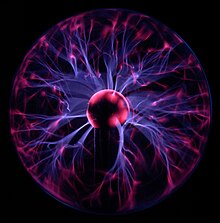Electric potential energy

An object can have potential energy by virtue of its electric charge and several forces related to their presence. There are two main types of this kind of potential energy: electrostatic potential energy, electrodynamic potential energy (also sometimes called magnetic potential energy).
Electrostatic potential energy
Electrostatic potential energy between two bodies in space is obtained from the force exerted by a charge Q on another charge q which is given by
where is a vector of length 1 pointing from Q to q and ε0 is the vacuum permittivity. This may also be written using Coulomb's constant ke = 1 ⁄ 4πε0.
If the electric charge of an object can be assumed to be at rest, then it has potential energy due to its position relative to other charged objects. The electrostatic potential energy is the energy of an electrically charged particle (at rest) in an electric field. It is defined as the work that must be done to move it from an infinite distance away to its present location, adjusted for non-electrical forces on the object. This energy will generally be non-zero if there is another electrically charged object nearby.
The work W required to move q from A to any point B in the electrostatic force field is given by
typically given in J for Joules. A related quantity called electric potential (commonly denoted with a V for voltage) is equal to the electric potential energy per unit charge.
Magnetic potential energy
The energy of a magnetic moment in an externally produced magnetic B-field B has potential energy
The magnetization M in a field is
where the integral can be over all space or, equivalently, where M is nonzero. Magnetic potential energy is the form of energy related not only to the distance between magnetic materials, but also to the orientation, or alignment, of those materials within the field. For example, the needle of a compass has the lowest magnetic potential energy when it is aligned with the north and south poles of the Earth's magnetic field. If the needle is moved by an outside force, torque is exerted on the magnetic dipole of the needle by the Earth's magnetic field, causing it to move back into alignment. The magnetic potential energy of the needle is highest when its field is in the same direction as the Earth's magnetic field. Two magnets will have potential energy in relation to each other and the distance between them, but this also depends on their orientation. If the opposite poles are held apart, the potential energy will be higher the further they are apart and lower the closer they are. Conversely, like poles will have the highest potential energy when forced together, and the lowest when they spring apart.






Comments
Post a Comment